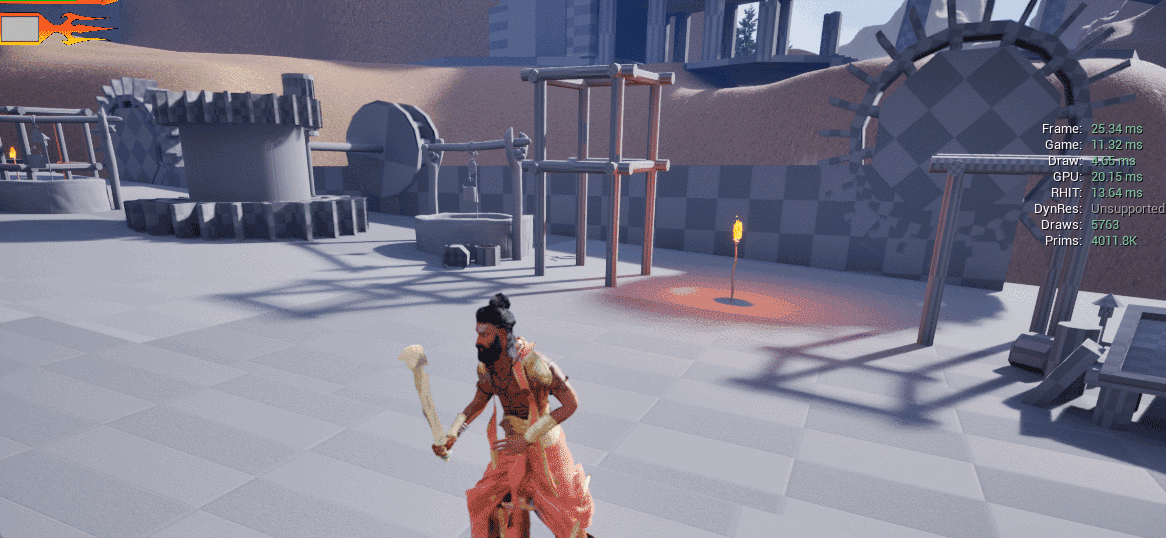Rudra: A Tale of Time
Role: Level Designer
-
Duration: Sep 2022- May 2023
-
Team: 18 Devs
-
Software used: Unreal 5, P4V, Jira
Contributions
-
Successfully contributed as a level designer on a 3rd person action RPG, the first RPG to incorporate Hindu mythology and Indian folklore into the gameplay, resulting in receiving national press (Time News) in India, and ABC4 locally.
-
Independently designed and blocked out compelling game levels, constructed environmental narratives to enhance gameplay and player experience, and incorporated Hindu mythology and iconography from conception to production.
-
Collaborated cross-functionally with environment artists and encounter & narrative designers to ensure that the player experience was iterated upon and that levels included historically accurate communities, tools, dwellings, religious structures, and landscapes.
Some Details - Unreal 5 BSP Block Out
2D Top-Down Map Break Down & Explanation

Reference Board / Mood Board
Design elements & Considerations
Overall, Yuga 3 presents the most deteriorated environment, featuring three distinct encounters that intricately weave together elements of Hindu mythology and Indian folklore.
First Encounter:
Outside the Temple (Defense Wall of Village)
-
Create a sense of urgency and chaos by incorporating crumbling walls, debris, and damaged structures.
-
Use strategic placement of cover objects like overturned carts, fallen pillars, or barricades to provide tactical advantages for players.
-
Consider introducing ranged enemies positioned on elevated platforms or rooftops, making it important for players to find effective vantage points.
Second Encounter:
Within the Village
-
Emphasize the impact of war by showcasing destruction, burnt houses, and displaced objects.
-
Design the encounter to take place in narrow streets, tight alleyways, or partially destroyed buildings, creating a claustrophobic and tense atmosphere.
-
Introduce a mix of enemy types, including melee-focused adversaries that ambush players in close quarters and ranged enemies that attack from windows or balconies.
-
Incorporate dynamic elements such as collapsing structures or fires that can alter the battlefield and force players to adapt their strategies.
Final Encounter:
Cave Behind the Village
-
Transition the level design from the chaotic outdoor environment to a mysterious and unsettling atmosphere as players enter the cave.
-
Use lighting and sound design to create a creepy ambiance, with dimly lit areas and distant echoes.



-
Consider the pacing of the encounters, ensuring a gradual increase in difficulty and a sense of progression as players move from one encounter to the next.
-
Incorporate a broken pathway within the cave that leads to a narrow passage connected to the boss level.
Temple Environment Design Elements & Consideration
-
Architecture: Hindu temples exhibit a wide range of architectural styles, with distinctive features such as towering spires (shikharas), elaborate entrance gates (gopurams), and intricate carvings depicting deities, mythological scenes, and sacred symbols.
-
Sanctum Sanctorum: The central chamber of a Hindu temple is the sanctum sanctorum, also known as the garbhagriha. It houses the main deity and is considered the most sacred space within the temple.
-
Mandapas: Temples often feature pillared halls called mandapas, which serve as gathering spaces for devotees, performances of religious ceremonies, and community events
-
Symbolism: Hindu temple architecture is rich in symbolism, with specific designs, patterns, and proportions representing cosmological concepts, the interplay of deities, and the union of the divine and the human.
-
Sacred Geometry: Temples often follow principles of sacred geometry, including precise measurements, alignments, and ratios believed to enhance the spiritual energy and harmony of the space.
-
Water Elements: Many Hindu temples incorporate water elements such as sacred tanks (pushkarinis) or stepped wells (baolis) for ritualistic bathing and purification purposes.
-
Sculptures and Carvings: Intricate sculptures and carvings adorn the temple walls and pillars, depicting scenes from Hindu epics, deities, celestial beings, and various mythological narratives.
-
Deity Worship: Hindu temples are dedicated to various deities and serve as places of worship. Rituals, prayers, and offerings are performed to honor and seek the blessings of the deity enshrined in the temple.
-
Ritualistic Practices: Temples serve as hubs of religious and cultural activities, hosting daily and festive rituals, processions, and celebrations that bring devotees together in communal worship.
-
Spiritual Experience: Hindu temples aim to create a sacred atmosphere that invokes a sense of devotion, and spiritual connection with the divine, providing a place for introspection, meditation, and transformation.
With in Village Environment Design Elements & Consideration
-
Organic Layout: Indian ancient villages typically had an organic layout, with narrow winding lanes and interconnected pathways that evolved over time. The village layout was often influenced by the surrounding topography and natural features.
-
Village Ponds or Lakes: Many ancient Indian villages had ponds or lakes that provided a water source for drinking, irrigation, and livestock. These water bodies also served as gathering spots and a scenic backdrop.
-
Community Bond: Ancient Indian villages fostered a strong sense of community and mutual support. Villagers relied on each other for tasks such as farming, water management, and creating a close-knit social fabric.
-
Traditional Dwellings: The houses in ancient Indian villages were typically made of locally available materials such as mud, thatch, or stone. They featured traditional architectural elements like sloping-roof, courtyards.
-
Temples and Sacred Spaces: Ancient Indian villages typically had temples or sacred spaces dedicated to deities or revered figures. These places served as centers for religious and spiritual activities, rituals, etc.
-
*Agrarian Lifestyle: Agriculture was the primary occupation in ancient Indian villages. The landscape often included fields, orchards, and grazing lands, with farming practices deeply embedded in the village's life.
-
Traditional Crafts and Trades: Villages often had artisans specializing in various traditional crafts and trades, such as pottery, weaving, blacksmithing, or carpentry. These skills were passed down through generations, contributing to the village's cultural richness.
-
Natural Surroundings: Indian villages were often situated amidst natural surroundings like forests, rivers, or hills. The village was intertwined with the natural environment, reflecting a close relationship with nature.


































